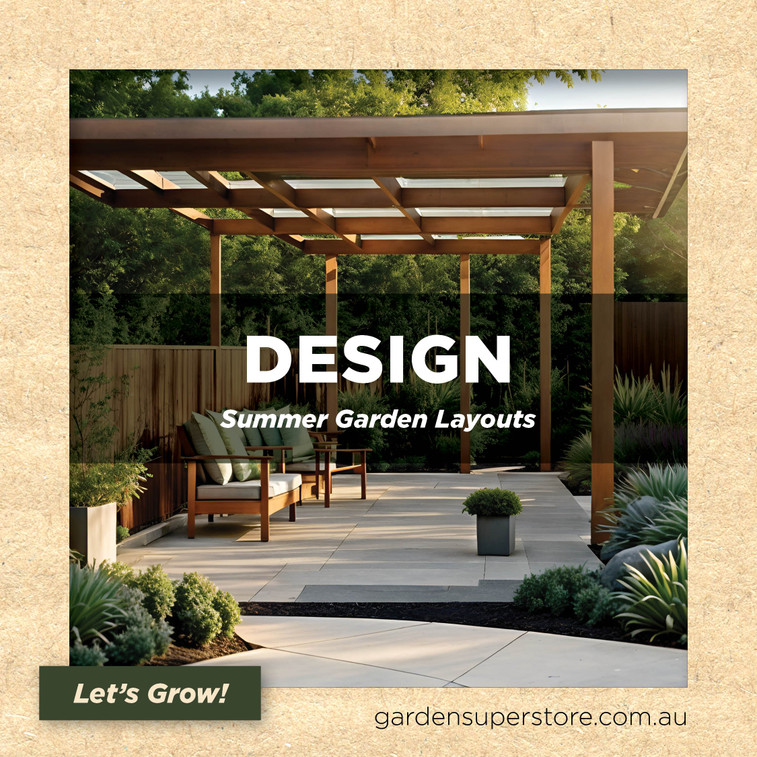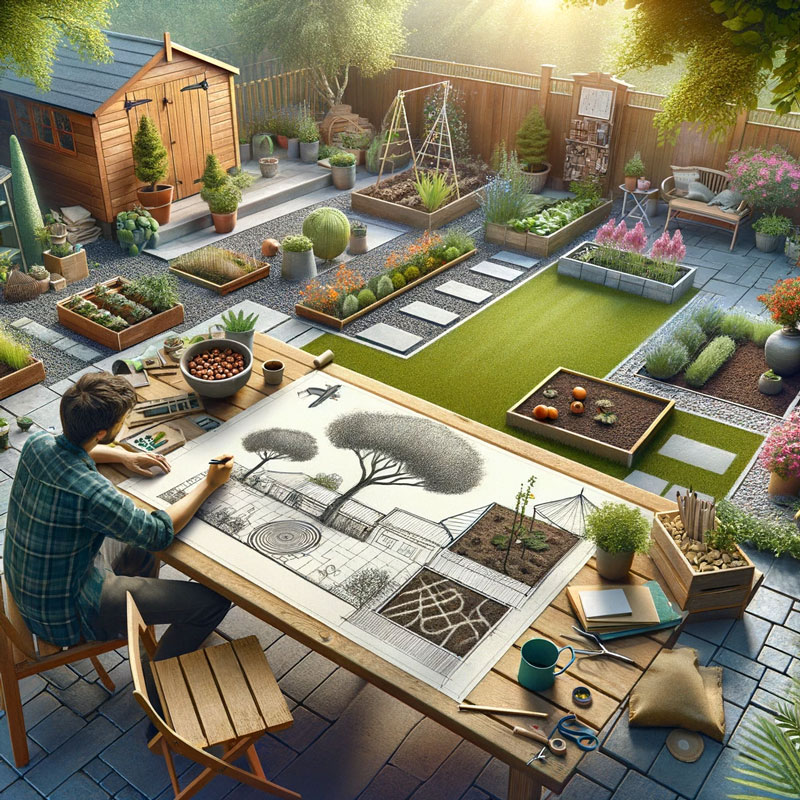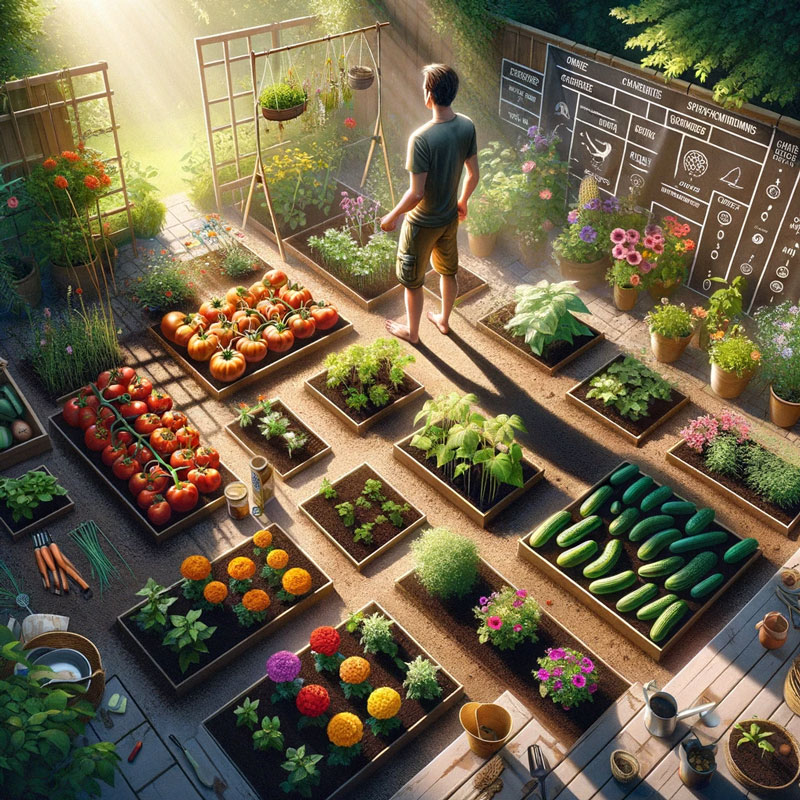
Garden Design: Plan Your Summer Garden Layout
Posted by Dale Parsons on 11th Jan 2024
As the warm embrace of summer begins to unfold, it's the ideal time for garden enthusiasts and beginners alike to embark on the joyful journey of creating their own vibrant summer garden. The allure of a garden that flourishes in the sunny season and serves as a personal haven is irresistible. In this comprehensive guide, we'll walk you through the steps to design a summer garden layout that is both aesthetically pleasing and functional.
Whether you're an experienced green thumb or just starting your first plot, this guide is crafted to assist you in realizing your garden dreams. Our aim is to combine creativity with practical gardening knowledge, ensuring your outdoor space is transformed into a flourishing oasis. We'll cover everything from understanding the unique aspects of your garden space to selecting the right plants and integrating beautiful features. We'll also share expert maintenance tips to keep your garden thriving all summer.
Gardening is more than just a pastime; it's an art and a science. With the right approach, your summer garden can become a source of pride, joy, and tranquillity. So, let's embark on this exciting gardening adventure together, and by the end of this guide, you'll be equipped with all the know-how to create a stunning and practical summer garden.
II. Understanding Your Space

Before you sow a single seed or place a plant, it's essential to intimately understand your garden's unique environment. This knowledge forms the backbone of your garden design, ensuring that every choice you make is tailored to your garden's specific needs.
A. Sunlight: The Lifeblood of Your Garden
- Tracking Sunlight: Spend a few days observing how sunlight moves across your garden. Note the areas that receive full sun and those that are shaded. Most summer plants thrive in 6-8 hours of direct sunlight, so identifying these sunny spots is key.
- Adjusting to Sunlight Variations: If parts of your garden receive less sunlight, don't worry. There are plenty of shade-loving plants that can beautify these spaces. The key is to match the plant's needs with your garden's reality.
B. Soil Type: The Foundation of Growth
- Soil Testing: Conduct a soil test to determine the type (clay, loam, sand) and pH level of your soil. This can often be done through local gardening centres or with at-home soil pH testing kits.
- Interpreting Results: Different plants require different soil types and pH levels. Once you know your soil's characteristics, you can choose plants that will naturally thrive in your garden or make informed decisions about amending your soil.
- Amending Soil: If your soil needs adjusting, incorporate organic matter like compost or specific soil amendments like gypsum to achieve the desired texture and pH. This step is crucial for creating a fertile ground that will support robust plant growth.
C. Garden Size: Maximizing Your Space
- Understanding Limitations and Possibilities: Be realistic about the size of your garden. It dictates not just what you can plant but how. In smaller spaces, think vertically with climbing plants or tiered planters.
- Strategic Planting: In larger gardens, you have the luxury of space but beware of overplanting. Remember that plants need room to grow and access sunlight and air circulation. Proper spacing is essential to prevent overcrowding and disease.
Understanding your garden space is a blend of science and observation. By taking the time to assess your garden's sunlight, soil, and size, you're laying the groundwork for a thriving summer garden.
III. Designing Your Layout

With a thorough understanding of your garden's unique characteristics, it's time to bring your summer garden vision to life. Designing your layout is a blend of practicality and creativity, allowing you to plan a beautiful and functional garden.
A. Sketching Your Garden: Visualizing Your Space
- Creating a Rough Sketch: Start by drawing a basic outline of your garden area. Include any permanent features like patios, paths, sheds, or large trees. This doesn't have to be a work of art or perfectly to scale, but it should give you a clear idea of your working space.
- Visual Elements: Add potential new features like beds, containers, or trellises. Consider the visual balance and flow of your garden. A well-designed garden leads the eye naturally through the space, creating a sense of harmony.
B. Zoning: Organizing Your Garden Intelligently
- Functional Zoning: Divide your garden into zones based on their purpose. For instance, you might have a vegetable patch, a flower bed, a herb garden, and a relaxation area. This helps manage different needs efficiently, like watering regimes and sun exposure.
- Plant Grouping: Group plants with similar needs together. This not only simplifies maintenance but can also create stunning visual effects. For example, a bed of vibrant flowers can be a focal point, while herbs near the kitchen offer convenience.
C. Pathways: Ensuring Accessibility and Flow
- Planning for Movement: Pathways are essential for easy access to all parts of your garden. They should be wide enough to walk through comfortably, possibly with garden tools or a wheelbarrow.
- Material Choices: Choose materials that complement your garden's style and are practical. Gravel, stepping stones, or bark chips can create different looks and experiences. Ensure they are laid out to provide stability and prevent water accumulation.
Designing your garden layout is a dynamic process involving adjusting and tweaking as you go. Remember, this is your personal space, and it should reflect your style and needs. Be open to changes as you start to see your garden taking shape.
IV. Choosing Plants

Selecting the right plants is a critical step in creating your summer garden. This decision should be guided by your garden's specific conditions and your personal preferences. Here's how to choose plants that will thrive in your summer garden and contribute to its beauty and functionality.
A. Selecting Climate-Appropriate Plants
- Understanding Local Climate: Research the climate zone of your area. This will give you an idea of what plants will naturally do well.
- Matching Plants to Garden Conditions: Choose plants that suit your garden's sunlight, soil type, and moisture level. Local garden centres can be invaluable resources for advice on plants that thrive in your area.
B. Vegetables for Sunny Gardens
- Tomatoes, Cucumbers, and Peppers: These are classic summer vegetables that love the sun. Plant them in the sunniest part of your garden.
- Planting Tips: Ensure they have enough space to grow, provide support for climbing varieties, and maintain consistent watering.
- Companion Planting: Consider companion planting to maximize space and improve plant health. For example, basil can be planted with tomatoes to enhance flavour and repel pests.
C. Flowers for Vibrant Colors
- Sun-Loving Flowers: Marigolds, petunias, and zinnias are excellent choices for adding vibrant colour. They thrive in full sun and can tolerate summer heat.
- Designing with Flowers: Use these flowers to create borders, fill in bare spots, or as centrepieces in your garden beds.
- Continuous Bloom: Choose varieties that bloom at different times to ensure a continuous display of colour throughout the summer.
D. Herbs for the Kitchen Garden
- Basil, Chives, and Oregano: These herbs are easy to grow and useful in the kitchen.
- Growing Conditions: Most herbs prefer well-drained soil and at least six hours of sunlight. They can be grown in-ground or in containers.
- Usage Tips: Regular harvesting encourages growth and ensures a fresh supply for your cooking needs.
Choosing the right plants is about balancing what works for your garden with what excites you. It's your garden, so let your personality shine through your plant choices. Consider the colours, textures, and fragrances you enjoy and integrate them into your design.
V. Integrating Features

After selecting your plants, the next step is to integrate additional features that enhance your garden's functionality and aesthetic appeal. These features can transform your garden into a more inviting and enjoyable space.
A. Seating Areas: Creating a Garden Sanctuary
- Purposeful Placement: Choose a spot for your seating area that allows you to enjoy the best view of your garden. It could be a sunny spot for morning coffee or a shaded area for afternoon relaxation.
- Comfort and Style: Select outdoor furniture that complements the style of your garden and offers comfort. Consider durable materials that withstand weather conditions.
- Adding Personal Touches: Enhance the area with cushions, outdoor rugs, or a small table for convenience and charm.
B. Water Features: Adding a Touch of Tranquility
- Types of Water Features: From a simple birdbath to a small fountain, water features add a calming element to your garden. They can also attract wildlife like birds and butterflies.
- Placement Considerations: Place your water feature where it can be easily seen and heard from your seating area. Ensure it's accessible for maintenance.
- DIY Options: There are many DIY kits available if you're interested in adding a personal touch. Remember to consider the power source for features like fountains.
C. Vertical Gardening: Maximizing Space and Creativity
- Ideal for Small Gardens: Vertical gardening is an excellent way to maximize your growing area if space is limited. It can also add visual interest to walls or fences.
- Choosing the Right Structures: Utilize trellises, wall planters, or hanging baskets. Ensure they are securely attached and can support the weight of the plants.
- Plant Selection: Vines, climbing flowers, and even some vegetables like tomatoes and beans are perfect for vertical gardening. Consider the sunlight and water needs of your vertical plants.
Incorporating these features into your garden enhances its beauty and extends its functionality, making it a space you'll want to spend time in.
VI. Maintenance Tips

A flourishing summer garden requires regular maintenance. You can ensure your garden stays healthy and vibrant throughout the season by employing the right techniques. Here are some essential maintenance tips to keep your garden at its best.
A. Watering Systems: Efficient Plant Hydration
- Choosing the Right System: Drip irrigation and soaker hoses deliver water directly to the roots with minimal waste. This is especially important in the hot summer months.
- Installation Tips: Install your watering system close to the root zone of your plants. Avoid overhead watering to reduce evaporation and prevent fungal diseases.
- Regular Checks: Monitor your watering system regularly to ensure it's functioning correctly and adjust the schedule according to weather conditions.
B. Mulching: A Multipurpose Solution
- Benefits of Mulching: Mulch helps retain soil moisture, suppress weeds, and can improve soil quality over time as it breaks down.
- Choosing Mulch: Organic mulches like straw, bark chips, or compost are great options. They perform the necessary functions and enhance the soil as they decompose.
- Application Technique: Apply a layer of mulch around your plants, but avoid piling it directly against stems or trunks to prevent rot.
C. Regular Pruning: Keeping Plants Healthy
- Importance of Pruning: Pruning is essential for maintaining plant health and encouraging productive growth. It can also help shape plants and keep your garden looking tidy. Using he correct pruning tools can make the job so much easier.
- Pruning Schedule: Different plants have different pruning needs. Generally, summer-flowering plants should be pruned in late winter or early spring, while spring bloomers can be pruned right after they flower.
- Pruning Technique: Use clean, sharp tools and make cuts at a 45-degree angle just above a bud or branch. This encourages new growth and helps prevent disease.
Remember, regular maintenance is key to a garden's longevity and beauty. By implementing these practices, you can enjoy a lush, healthy garden that is a joy to spend time in.
VII. Conclusion
In conclusion, designing your summer garden is a journey of creativity, patience, and learning. It's an opportunity to create a space that reflects your personal style and fulfils your gardening aspirations. We hope this guide has inspired you and provided you with the knowledge and tools to create a stunning and functional summer garden.
Remember, The Garden Superstore is here to support you every step of the way. We have a range of products for every gardener. We cater to all levels of gardening expertise, ensuring you have the best resources at your fingertips.
Thank you for joining us on this gardening adventure. We wish you a joyous and fruitful gardening season! Happy gardening!
